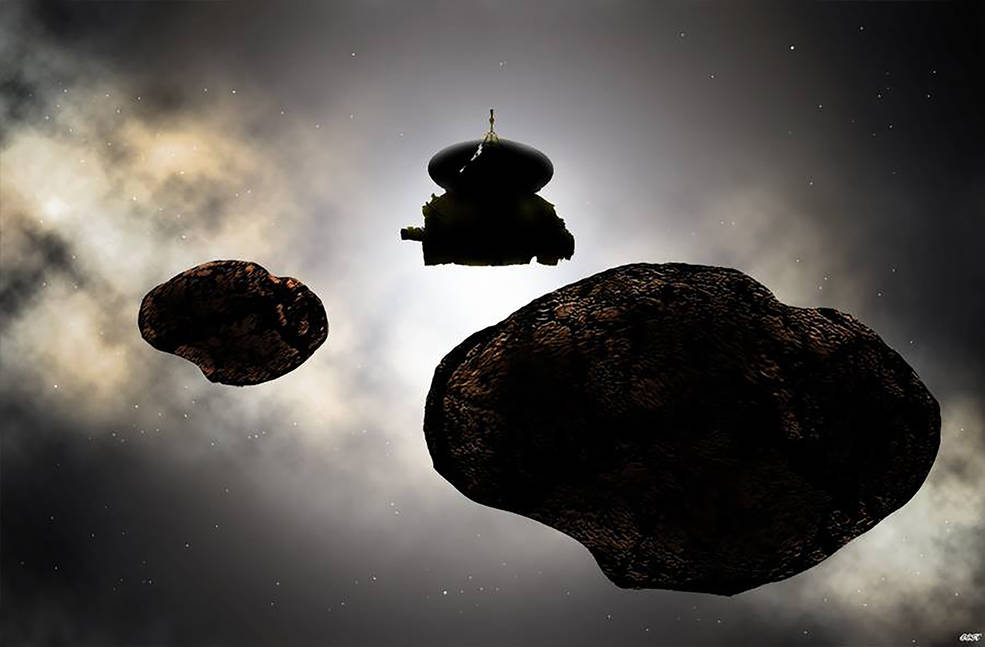
NASA's New Horizons spacecraft will get three times closer to its next flyby target than it got to Pluto in July 2015, if all goes according to plan.
Mission team members aim to steer New Horizons within just 2,175 miles (3,500 kilometers) of the distant object 2014 MU69 in the Jan. 1, 2019 flyby, NASA officials announced Wednesday (Sept. 6).
During its epic Pluto flyby on July 14, 2015, New Horizons never got closer than 7,800 miles (12,550 km) to the dwarf planet's icy surface. [Destination Pluto: NASA's New Horizons Mission in Pictures]
"We're planning to fly closer to MU69 than Pluto to get even higher-resolution imagery and other datasets," New Horizons principal investigator Alan Stern, of the Southwest Research Institute in Boulder, Colorado, said in a statement. "The science should be spectacular."
New Horizons' sharpest Pluto photos resolved surface features as small as 600 feet (183 meters) across. But a flyby distance of 2,175 miles should allow the probe to spot details just 230 feet (70 m) wide on 2014 MU69, NASA officials said.
This superclose approach isn't set in stone, however: A backup plan calls for New Horizons to cruise 6,000 miles (9,600 km) from 2014 MU69, if the team spots debris around the object.
The mission team has already hunted for such debris, during a recent globe-crossing campaign to observe 2014 MU69 blocking the light from several different background stars. Study of such "occultations" can reveal a great deal about the foreground body, including its shape and size.
Get the Space.com Newsletter
Breaking space news, the latest updates on rocket launches, skywatching events and more!
The occultation observations returned some intriguing data: 2014 MU69 may actually be two close-orbiting bodies, or two objects stuck together (what's known as a "contact binary"). These two objects (or two lobes, depending on the nature of MU69) appear to be about 11 miles and 12 miles (18 and 19 km) wide, team members said.
Everything will become much clearer, of course, as New Horizons approaches, and then flies by, 2014 MU69, which lies about 1 billion miles (1.6 billion km) beyond Pluto.
"Reaching 2014 MU69, and seeing it as an actual new world, will be another historic exploration achievement," New Horizons project manager Helene Winters, from the Johns Hopkins University Applied Physics Laboratory in Laurel, Maryland, said in the same statement. "We are truly going where no one has gone before. Our whole team is excited about the challenges and opportunities of a voyage to this faraway frontier."
The $700 million New Horizons mission launched in January 2006. The probe captured the first-ever good photos of Pluto during its historic 2015 flyby, revealing a stunning diversity and complexity of terrain on the faraway world. The 2019 encounter with 2014 MU69 is the centerpiece of an extended mission approved by NASA last year.
Follow Mike Wall on Twitter @michaeldwall and Google+. Follow us @Spacedotcom, Facebook or Google+. Originally published on Space.com.
Join our Space Forums to keep talking space on the latest missions, night sky and more! And if you have a news tip, correction or comment, let us know at: community@space.com.

Michael Wall is a Senior Space Writer with Space.com and joined the team in 2010. He primarily covers exoplanets, spaceflight and military space, but has been known to dabble in the space art beat. His book about the search for alien life, "Out There," was published on Nov. 13, 2018. Before becoming a science writer, Michael worked as a herpetologist and wildlife biologist. He has a Ph.D. in evolutionary biology from the University of Sydney, Australia, a bachelor's degree from the University of Arizona, and a graduate certificate in science writing from the University of California, Santa Cruz. To find out what his latest project is, you can follow Michael on Twitter.









